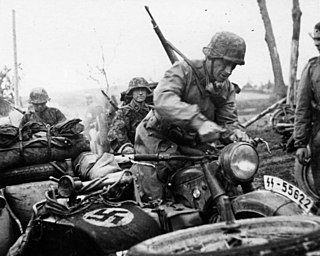
The Waffen-SS was the combat branch of the Nazi Party's Schutzstaffel (SS) organisation. Its formations included men from Nazi Germany, along with volunteers and conscripts from both occupied and unoccupied lands.
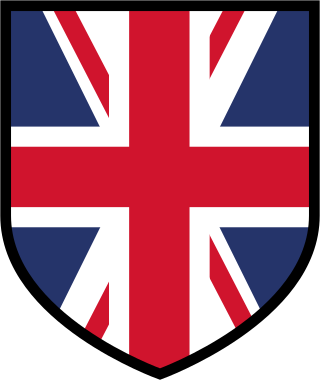
The British Free Corps was a unit of the Waffen-SS of Nazi Germany during World War II, made up of British and Dominion prisoners of war who had been recruited by Germany. The unit was originally known as the Legion of St George. Research by British historian Adrian Weale has identified 54 men who belonged to this unit at one time or another, some for only a few days. At no time did it reach more than 27 men in strength.
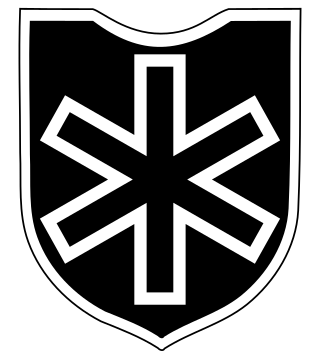
The 6th SS Mountain Division "Nord" was a German unit of the Waffen-SS during World War II, formed in February 1941 as SS Kampfgruppe Nord.

The uniforms and insignia of the Schutzstaffel (SS) served to distinguish its Nazi paramilitary ranks between 1925 and 1945 from the ranks of the Wehrmacht, the German state, and the Nazi Party.
SS-Verfügungstruppe was formed in 1934 as combat troops for the Nazi Party (NSDAP). On 17 August 1938 Adolf Hitler decreed that the SS-VT was neither a part of the Ordnungspolizei nor the Wehrmacht, but military-trained men at the disposal of the Führer. In time of war, the SS-VT were to be placed at the disposal of the army.
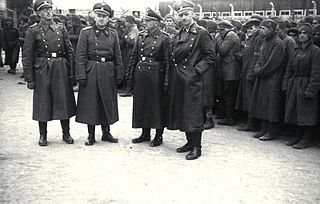
SS-Totenkopfverbände was the Schutzstaffel (SS) organization responsible for administering the Nazi concentration camps and extermination camps for Nazi Germany, among similar duties. While the Totenkopf was the universal cap badge of the SS, the SS-TV also wore this insignia on the right collar tab to distinguish itself from other SS formations.
Azerbaijani SS volunteer formations were recruited from prisoners of war, mainly from the Soviet Union and the countries annexed by it after 1939. Nazi Germany organised them to fight against the Soviet Union.

Reginald Eric Pleasants was a British national who joined the Waffen-SS serving in the British Free Corps during the Second World War.

Roy Nicolas Courlander,, nicknamed 'Reg', was a British-born New Zealand soldier who became an Unterscharführer in the German Waffen-SS British Free Corps during the Second World War.
Units and commands of the Schutzstaffel were organizational titles used by the SS to describe the many groups, forces, and formations that existed within the SS from its inception in 1923 to the eventual fall of Nazi Germany in 1945.
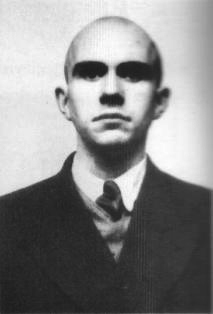
Thomas Haller Cooper, also known as Tom Böttcher, was a member of the German Waffen-SS British Free Corps and former member of the British Union of Fascists.

During World War II, the Waffen-SS recruited significant numbers of non-Germans, both as volunteers and conscripts. In total some 500,000 non-Germans and ethnic Germans from outside Germany, mostly from German-occupied Europe, were recruited between 1940 and 1945. The units were under the control of the SS Führungshauptamt beneath Reichsführer-SS Heinrich Himmler. Upon mobilization, the units' tactical control was given to the Oberkommando der Wehrmacht.

Roman Zenzinger was an Austrian artist and commercial designer best known for his intense portraits and sketches of soldiers during World War II.

George Frank McLardy MPS was a member of the British Union of Fascists, a British Nazi collaborator and an Unterscharführer in the Waffen-SS British Free Corps during the Second World War.

Kenneth Edward Jordan Berry was a British seaman who was taken as a prisoner of war in 1940 when his ship was sunk. While in prison camp he was persuaded to join the British Free Corps of the Waffen-SS as an SS-Mann during the Second World War. He was associated with the unit until 29 April 1945, when he could not be found when the Corps were leaving Neustrelitz, and was left behind. He received a nine-month sentence after the war, 'the lightest sentence passed on any traitor'.

Alfred Vivian Minchin was a British merchant seaman who was taken prisoner by a German destroyer after his ship, the SS Empire Ranger, one of a Murmansk convoy, was sunk by German bombers off Norway. He held the rank of Sturmmann in the Waffen-SS British Free Corps during the Second World War. He was taken prisoner on 28 March 1942. It was he who suggested the name for the British Free Corps. By 8 March 1945 he 'was being treated for scabies in the SS hospital at Lichtefelde-West.' The National Archives holds the depositions for his trial at the Central Criminal Court under reference CRIM 1/485 and a Home Office file on him under reference HO 45/25817. He was "convicted at Central Criminal Court on 5 February 1946 of conspiring to assist the enemy and sentenced to 7 years' penal servitude" for offences against the Defence Regulations. He died in Somerset in February 1998 at the age of 81.
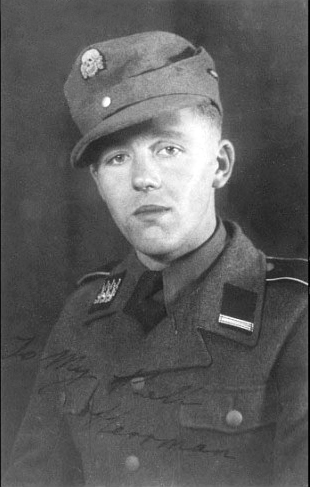
William Charles Brittain was a lance-corporal of the Royal Warwickshire Regiment who was serving in No. 4 Commando at the time of his capture in Suda Bay, Crete, in June 1941. During the Second World War he became a member of the "staff" at the PoW "holiday camp" in Genshagen, Berlin in mid-1943 and later a Rottenführer in the Waffen-SS British Free Corps. In February 1945 while in Dresden, he said he "had long since lost his enthusiasm for the unit and was planning to escape". During a conversation with his girlfriend, a Norwegian nurse, he boasted of his plans and also claimed that he had foreknowledge of the bombing raids. Shocked by this, she denounced him almost immediately to the Gestapo and the BFC were arrested en masse. "[His] court-martial ... took place at Colchester in June 1946 and he received a ten-year sentence. Two months later he was found to be suffering from an incurable form of Crohn's disease and he was released.
Henry Alfred Symonds was a British soldier who served in the British Free Corps of the Waffen-SS during World War II, attaining the rank of Rottenführer
In Nazi Germany, the Standarte was a paramilitary unit of Nazi Party (NSDAP), Sturmabteilung, NSKK, NSFK, and Schutzstaffel (SS). Translated literally as "Regimental standard", the name refers to the flag paramilitary formations carried in formations and parades.













